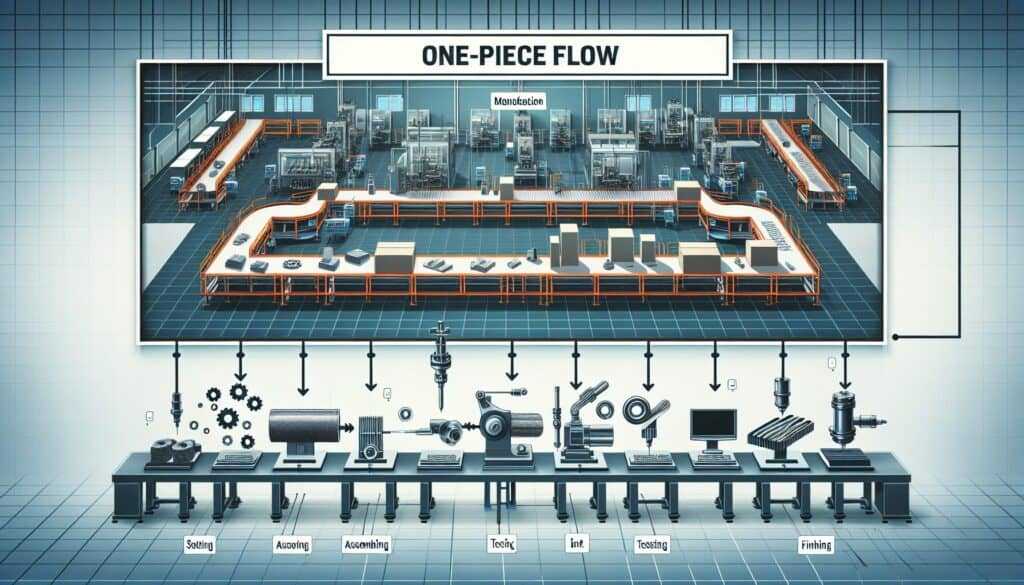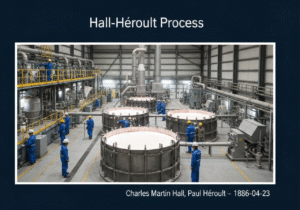To produce and move one item at a time (or a very small batch) between operations, rather than processing in large batches.
- Methodologies: Economics, Lean Sigma, Manufacturing, Problem Solving, Quality
One-Piece Flow

One-Piece Flow
- Continuous Improvement, Just-in-Time (JIT), Lean Manufacturing, Lean Production, Process Optimization, Production Efficiency, Quality Management, Value Stream Mapping, Waste Elimination Strategies
Objective:
How it’s used:
- Arranges workstations in sequence, allowing a single unit to pass through all process steps without work-in-process (WIP) accumulation or delays. Closely associated with Just-In-Time and cellular manufacturing.
Pros
- Reduces WIP inventory, lead times, and space requirements; Improves quality by enabling rapid feedback and defect detection; Increases flexibility and responsiveness to customer demand; Simplifies production control.
Cons
- Requires stable and reliable processes with high uptime and consistent quality; Can be challenging to balance workloads across all operations; May require significant layout changes and operator cross-training; Less suitable for processes with very long setup times.
Categories:
- Lean Sigma, Manufacturing
Best for:
- Creating a highly efficient, continuous, and responsive production system, especially in environments with a variety of products.
One-Piece Flow is commonly employed in industries such as automotive manufacturing, electronics, and consumer goods, where speed and efficiency are paramount due to high competition and rapid market changes. This methodology is particularly effective during assembly processes and demands a high degree of coordination among teams, prompting cross-functional collaboration between engineers, designers, and production staff to optimize workflow. Initiated by lean practitioners or process improvement teams, it often begins in pilot projects or specific product lines, enabling organizations to assess feasibility before a full-scale rollout. Implementation requires a thorough understanding of product variations and customer demand patterns to effectively operate the flow with minimal disruption. Techniques such as Value Stream Mapping may be utilized to identify bottlenecks and enhance layout design for improved flow, directly influencing cycle times and inventory levels. Industries employing One-Piece Flow benefit from enhanced customer satisfaction due to reduced lead times and improved responsiveness to shifts in demand, making it especially suited for environments where customization is valued. The integration of technology, like real-time data tracking systems, reinforces this methodology by providing visibility into each step of the process, facilitating quicker adjustments to production schedules when necessary. Training and involvement of all stakeholders, including shop floor workers and management, are crucial in sustaining these improvements, creating a culture that supports continuous improvement and innovation throughout the production cycle.
Key steps of this methodology
- Design the layout for workstations in a linear sequence based on the product flow.
- Implement standardized work procedures at each workstation to ensure consistency.
- Train operators on multi-tasking to reduce dependency on specific roles.
- Establish pull signals to trigger production based on current demand.
- Monitor workflow continuously to identify and eliminate bottlenecks.
- Integrate quality control checks at each workstation for immediate feedback.
- Encourage cross-functional collaboration to address issues as they arise.
- Utilize visual management tools for real-time tracking of production progress.
- Conduct regular assessments to optimize the flow and adjust processes as necessary.
Pro Tips
- Conduct regular process mapping sessions to identify and eliminate bottlenecks within the one-piece flow, ensuring optimal alignment of workstations.
- Implement real-time data monitoring to analyze cycle times and adjust workflows dynamically, enhancing responsiveness to demand fluctuations.
- Utilize standardized work instructions across all stations, fostering consistency and enabling rapid training of personnel to maintain flow integrity.
To read and compare several methodologies, we recommend the
> Extensive Methodologies Repository <
together with the 400+ other methodologies.
Your comments on this methodology or additional info are welcome on the comment section below ↓ , so as any engineering-related ideas or links.
Historical Context
1890
1924
1930
1940
1950
1950
1958
1886-04-23
1897
1930
1940
1949
1950
1950
1960
(if date is unknown or not relevant, e.g. "fluid mechanics", a rounded estimation of its notable emergence is provided)















Related Posts
Master Production Schedule (MPS)
Mass Customization
Marketing Funnel
Marketing Audit
MAPO Index (Movement and Assistance of Hospital Patients)
Manufacturing Resource Planning (MRP II)